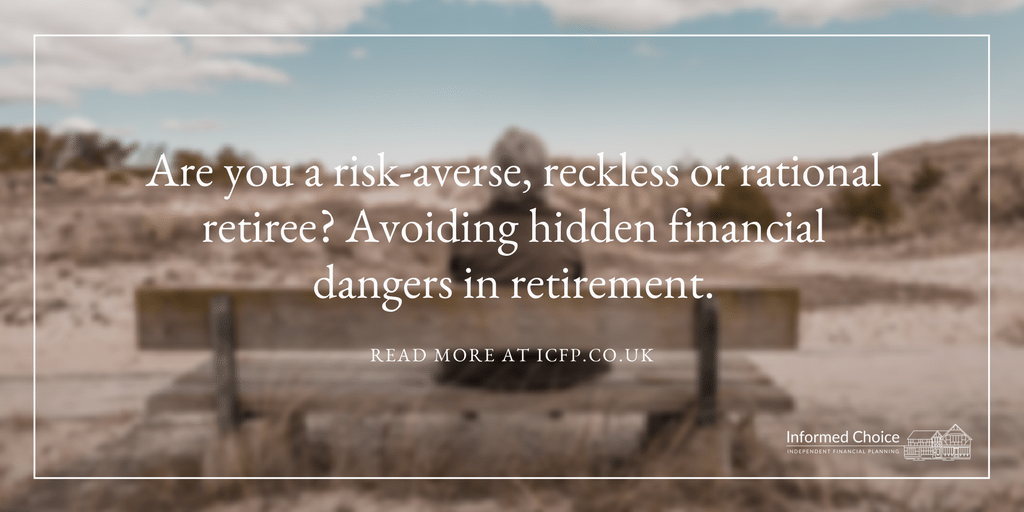Retirement should be an enjoyable period of life, but financial worries often mean retirees are concerned about avoiding hidden retirement dangers.
A new research report from mutual insurer Royal London is warning pensioners about two very different risks when it comes to making important decisions with their savings in retirement.
These hidden retirement dangers are especially relevant in a world of ‘pension freedoms’.
The two dangers Royal London highlight for savers in retirement are:
-taking ‘too little’ risk – the ‘risk averse’ retiree;
-taking ‘the wrong sort’ of risk – the ‘reckless’ retiree.
According to the insurer, each of these approaches increases the danger of a saver either running out of money during their retirement or having to face a reduced standard of living.
Are you a risk-averse, reckless or rational retiree? Share on XRisk-averse retiree
For the risk-averse retiree, taking too little risk with their money might look like taking the maximum tax-free cash from their pension savings at retirement and keeping their money in cash savings or a cash ISA.
This approach is sometimes taken in the mistaken belief it’s the ‘safe’ approach in retirement.
The Royal London research explains that such a risk-averse strategy can be risky because ‘investing in retirement is still long-term investing’.
With increasingly longer lives and more time spent in retirement, decades of low-return saving can seriously damage the living standards of retirees.
Royal London highlights the case of someone who retired ten years ago with an illustrative pension pot of £100,000 which they invested in cash.
Assuming they withdrew money at £7,500 per year (in line with annuity rates at the time), they would now be down to £27,000 and likely to run out in around four years’ time, less than fifteen years into retirement.
By contrast, if the same money had been invested in UK shares, there would still be around £48,000 left in the pot, despite the 2008 stock market crash.
Reckless retiree
On the other hand, the reckless retiree might be taking the ‘wrong sort of risk’ with their retirement wealth.
Royal London explain that, in an era of low interest rates, retired people may be tempted to seek out more unusual forms of investment with apparently high rates of return but accompanied by much greater risk to their capital.
Examples of such risk-seeking behaviour could include peer-to-peer lending, investment in aircraft leasing or even cryptocurrencies such as Bitcoin.
Concentrated exposure to a single, potentially volatile, investment can produce very poor outcomes, particularly if bad returns come early in retirement. This is a financial planning phenomenon often described as sequence of return risk, where losses experienced earlier in retirement result in poor longer-term outcomes, even if the average returns experienced are as expected by comparison to historical performance.
The pension pot in our previous example would still have £88,000 in it if the bad year for UK shares had happened at the end of the ten-year period we looked at and not at the start.
Rational retiree
But what about the rational retiree who takes a more sensible approach to avoiding hidden retirement dangers?
Rather than invest in an ultra-low risk way or chase individual high-risk investments, the Royal London paper identifies a ‘third way’ of spreading risk across a range of assets, including company shares, bonds and property, both at home and abroad.
This multi-asset approach, which is in line with the approach recommended by Informed Choice, can be expected to provide better returns over retirement than cautious investing in cash but also helps to smooth the ups and downs of individual investments.
Commenting on the research, Trevor Greetham, Head of Multi Asset at Royal London Asset Management said:
Pension freedoms open up new possibilities for people in retirement, but create new dangers as well.
There is the danger of being too cautious and not making your money work hard enough – investing in retirement is still long-term investing.
There is also the danger of taking the wrong sort of risk, chasing high returns but putting your capital at risk.
Here at Informed Choice we believe that a multi-asset approach to investing is likely to deliver the optimal outcome during a typical retirement.
Taking too little or too much risk with your money in later life are two approaches both equally likely to deliver poor outcomes.
Providing sufficient capital growth or income to sustain a desired lifestyle over a twenty, thirty or forty year retirement is likely to require exposure to a range of investment assets, ranging from cash to company shares.
What every individual entering retirement needs is a tailored financial plan which is personalised to suit their individual needs, goals and objectives.


